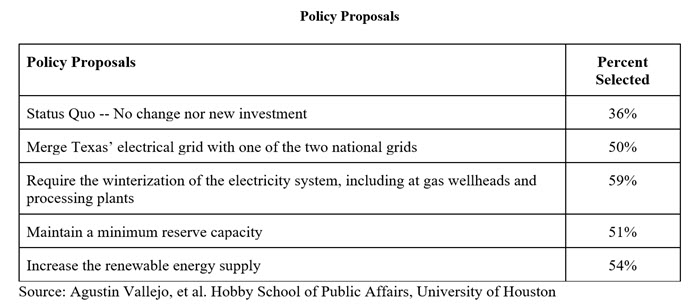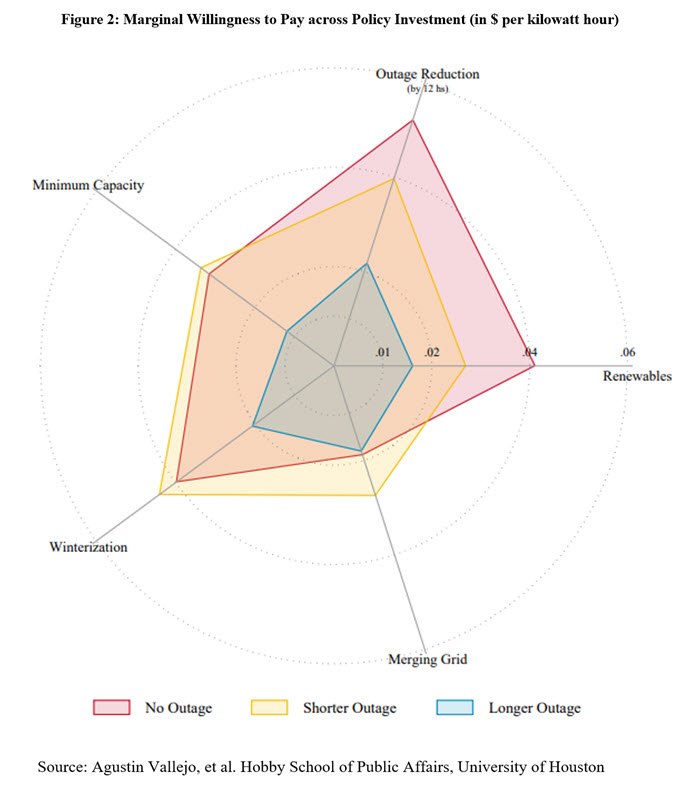Editor’s note: This post is part of a new series about the impacts natural disasters have on a region’s public health, economic activity, and individual decision-making. While the papers cited in the posts extend beyond natural disasters in Texas, the results will be contextualized to the state’s population. For more about this series, click here.
The third paper of this blog series, “Natural Disasters and Willingness to Pay for Reliable Electricity: The 2021 Winter Storm in Texas as a Natural Experiment,” is one of the first academic studies of Winter Storm Uri that shocked Texas’ electrical grid in February 2021. Researchers from the University of Houston’s Hobby School of Public Affairs fielded an online survey one month after the freeze. The sample consisted of 1,500 residents across the state who were asked about their experiences during the storm and their subsequent opinions regarding proposed changes to Texas’ electric system.
The researchers implemented a choice experiment, where they prompted respondents to select between bundles that included: (1) a policy change, (2) the cost of the change incurred by the individual in kilowatt hours (kWh), and (3) the policy’s effectiveness in terms of individual exposure to future power outages. The menu consisted of five policies that received significant attention after the storm, and each policy was randomly assigned a cost (from $0.00 to $0.06 more per kWh paid by the individual) and effectiveness (from 0 to 12+ hours of potential power outages) (Figure 1). The survey repeated this exercise four times for each respondent.

As expected, Texans prefer options that generate lower costs and fewer outages. There is a clear consensus for proactive measures to protect against future grid vulnerability, and the most popular option is to winterize the system (see table).

Policy preferences vary, however, depending on respondents’ experiences during Winter Storm Uri. In particular, individuals who never lost power are more likely to prefer increasing the renewable energy supply or requiring a minimum reserve capacity compared with those who experienced rolling blackouts. Respondents who suffered longer-than-average outages are more likely to prefer merging the Texas grid with one of the two national grids.
Using a mixed logit model, the researchers estimate individuals’ willingness to pay for each policy proposal. Despite disproportionate exposure to the electrical grid’s failure, respondents experiencing above-average outages are less willing to pay for all measures (Figure 2). The authors discuss the possibility that negative experiences during Winter Storm Uri may have decreased individuals’ confidence in energy service providers, thereby making them less likely to trust the competence of institutions and the effectiveness of policy in general. Indeed, households who suffered longer-than-average outages are more likely to blame electricity producers and the government for the blackouts compared with those who suffered shorter or no outages.

Winter Storm Uri revealed the vulnerabilities of Texas’ electrical grid and prompted a discussion of how to protect against extreme weather that has persisted two years after the storm. With an array of policy proposals heading into the 2023 legislative session, it is imperative that leaders maintain a pulse on public opinion and understand how that pulse was impacted by individual experiences during the disaster.
